The Recycling of Plastic - A Recuperation Technology
Written by Fulmina Institut
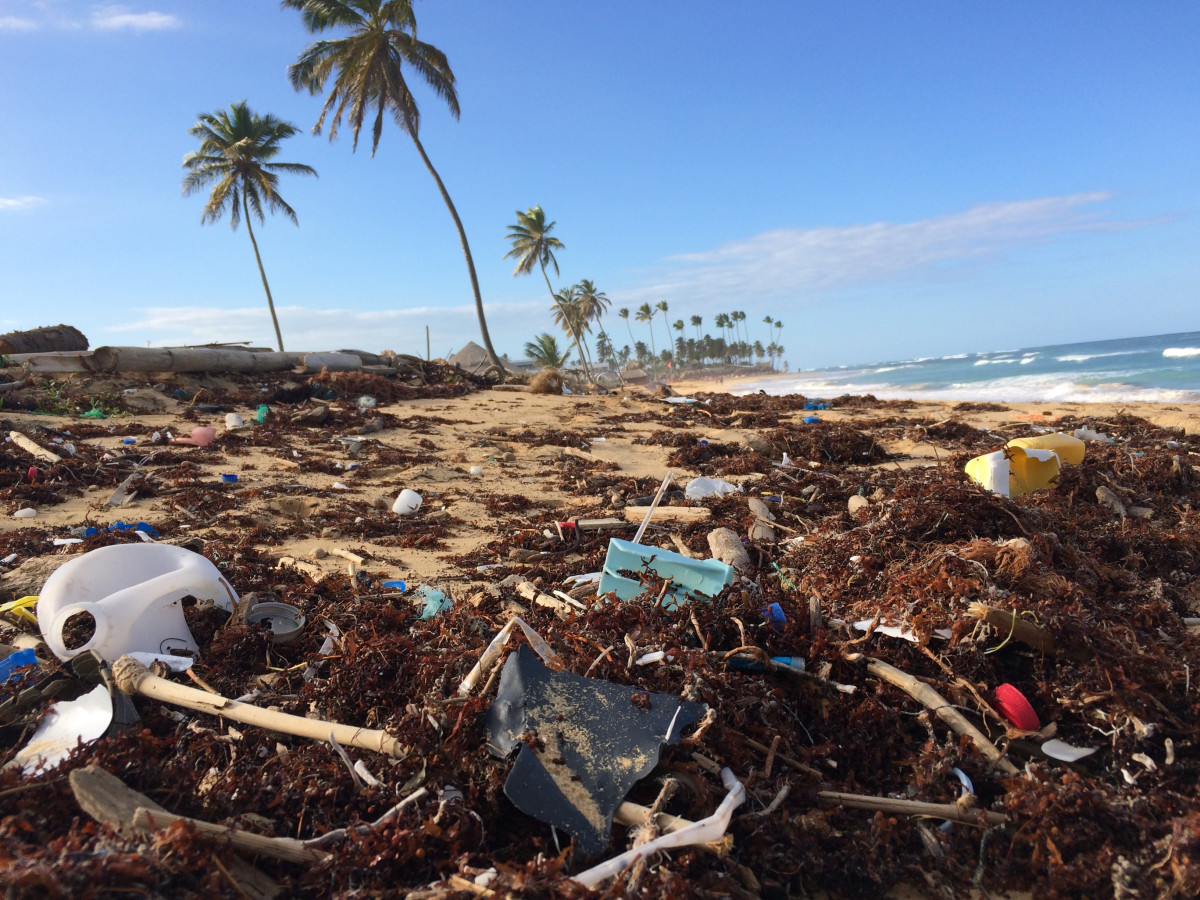
Presented by Fulmina Institut
And PROOF LLC By Dr. Robert Abraham Hallowitz, MD, CEO, David Brooks Nixon, Partner
July 2017
Preamble
Plastic was a nice invention. But it turned out to be an ecological catastrophe. Contrary to glass, humans don’t seem to have any respect for a plastic object. They are being thrown away everywhere. The oceans seem to have become the cemetery of everything plastic. Difficult to recycle, waste disposal organizations do not seem to know what to do with plastic. They end up filling the oceans and only the oceans seem to be able to recycle them – but in fact the oceans only succeed in breaking them in small particles that fish swallow. Plastic is difficult to recycle.
Worst of all, these little plastic bits are now taking the ocean space that should be inhabited by the phytoplankton. These little living plants are responsible for the creation of the oxygen we breathe. Less phytoplankton, less oxygen to breathe. We are heading into a wall.
This report has been produced by the scientists associated with PROOF LLC.; it was submitted for analysis to the Academy of the Fulmina Human Resources Foundation.
Narrative Discussion of Plastic to Oil Technology
The OWR-Kaua`i Unrecycled Plastics to Oil Module will consist of 20 tons of plastic per day pyrolysis reactors that will process the anticipated plastic content for 70,000 tons of MSW plus 20-years growth in tonnage. The Pyrolytic reactor technology is operational in more than 170 commercial facilities that convert plastic into oil. The Plastics to Oil Module will generate SynCrude for processing by the Crude Oil Separation unit as well as SynChar and gas that are used as fuel for the Power Module.
The plastics will be processed by the shredders in the Recycling Module to 2” minus, then fine shredded to flake size and stored until needed in a 1st in/ 1st out silo to be subsequently fed to the Unrecycled Plastic to Oil Module. The Recycling Module will have previously extracted the PET, metals and glass prior to shredding. The Plastic to Oil Module will operate the number of hours per day needed to consume the plastics.
Note :
OWR - Organic Waste Remediation. OWR LLC is a US corporation.
MSW - Municipal Solid Waste
OWR Processes Plastics into Oil as Part of a MSW Reuse Process
OWR LLC was established to Reuse as much Municipal Solid Waste (MSW) as possible as beneficially as possible, thereby eliminating the need for Class I landfills. OWR can reuse more than 90% of MSW, almost all organics, by extensive recycling (~40%), converting unrecycled plastics into SynCrude (~10%) using a Nacks Process and reusing virtually all of the unrecycled organics (~40%+). The unrecycled organics can be:
Shred and cleanly consumed by a Fluid Bed Gasification Boiler to generate electricity replacing hydro-carbons as fuel. Fluid Bed Boilers have vastly improved environmental and operational attributes compared with the conventional Waste-to-Energy technology.
Shred, de-watered and pelletized and sold as fuel to concrete plants and other industrial processes replacing hydro-carbons as fuel.
Shred, de-watered and pelletized and converted into Pyrolytic Fluid (~Crude Oil with 20% to 40% Oxygen content) in a fast pyrolysis process and then converted into BioCrude by using a HydroTreater that injects Hydrogen to combine with the Oxygen.
This is potentially the best option but is presently not cost competitive with Crude Oil out of the ground. E2MC intends to fund research with the goal of eliminating costs.
Plastic to Oil Technology Can Process Ocean Plastic as Well
The PET in the ocean will be easy to recognize. PVC is expected to be a trivial part of the ocean plastic. An ocean-going ship is required that can gather the floating plastic and then be treated by 20 tons per day Nacks Plastic to Oil units. They will generate SynCrude, SynChar and SynGas.
Note :
PET - Polyethylene terephtalate
PVC - Polyvinyl Chloride
Ocean Plastics to Oil Module
An Ocean Plastics to Oil Module will consist of the number of shredders and 20 tons of plastic per day pyrolysis reactors needed to meet anticipated demand.
Unrecycled Plastics to Oil Module Material Receiving & Pre-Processing
The unrecycled plastics will be shredded to 2 inches’ minus and shredded to flake size in the Recycling Module prior to being blown from the Recycling Module into the top of the unrecycled plastics feed bunker in the Plastics to Oil Module building. The primary function of the plastics feed bunker is to level the non-linear delivery pattern of unrecycled plastics until the Plastics to Oil Module is operated. At the start-up of the Plastics to Oil Module, the plastic will be extracted from the bottom of the bunker providing a first in, first out feature. The shredded plastic will be blown to each of the Plastics to Oil machines.
Ocean Plastics to Oil Module Equipment
Nacks/ Blest/ E-Nergy has sold more than 170 Plastic to Oil machines around the world in the last 10 years. These machines have been continually increased in capacity. Each new machine has been about twice as big as the last in order to ensure that the relationship between inputs and outputs are at least maintained and that heat efficiency is continually improved. 2.5 tons of plastic per day machines have been in operation in Japan for more than 5 years. All of the commercial throughput machines have been designed by Dr. Kiyoshi Nakajima. Dr. Nakajima will be working with E2MC. Dr. Nakajima has designed a new 5 ton per day machine and a 20 ton/ day machine, both of which will be built in the US by E2MC.
Pyrolysis Definition
Pyrolysis is the breaking down of organics in the presence of heat in the absence of Oxygen. Pyrolysis breaks the organics down into SynGas, SynChar and SynCrude in the case of plastics, rubbers or organics with oil content like pine wood. The processing of food waste or yard waste with “Fast Pyrolysis” generates Pyrolytic Fluid instead of SynCrude as well as BioChar and BioGas.
After Processes
The SynGas and BioGas are chemically similar and can be converted to electricity with the use of a gas turbine or a diesel modified to consume gas. SynChar as generated by the Nacks process is Carbon soaked in oil and can be burned in a boiler as fuel. BioChar is Carbon which, if processed from uncontaminated organics, can be used as a valuable soil amendment. BioChar can also be used as a fuel in a boiler. SynCrude, from plastic or rubber, has been directly used in diesel engines after being evenly mixed with diesel oil which is the proposed option on a Plastic from the Ocean Ship-board Process. SynCrude can also be processed by a refinery to generate Naphtha, Kerosene, Diesel Oil, Fuel Oil and Bitumen that meets industry specifications. Pyrolytic Fluid is, simplistically, Crude Oil with 20% to 40% Oxygen which makes it very caustic, hard to handle and dangerous. An explosion requires fuel, Oxygen and a spark. Pyrolytic Fluid has two of the three. Pyrolytic Fluid can be converted into Crude oil with the use of a HydroTreater. A HydroTreater simplistically injects Hydrogen into the Pyrolytic Fluid which combines with the Oxygen to create water which can be easily separated. The HydroTreater option is proven but is too expensive to compete with oil out of the ground. E2MC will fund an R&D Program with Battelle to find a cost competitive option.
Why the Nacks Process is Superior to Alternatives
Almost all Pyrolysis units use vacuum pumps to eliminate Oxygen (as done by OWR) or use a Quasi-Inert gas such as Nitrogen to blanket the organics to minimize Oxygen. These are both costly due to high maintenance needs. The Nacks Process elegantly processes the plastic in processed oil to eliminate Oxygen. Maintenance costs are minimal.
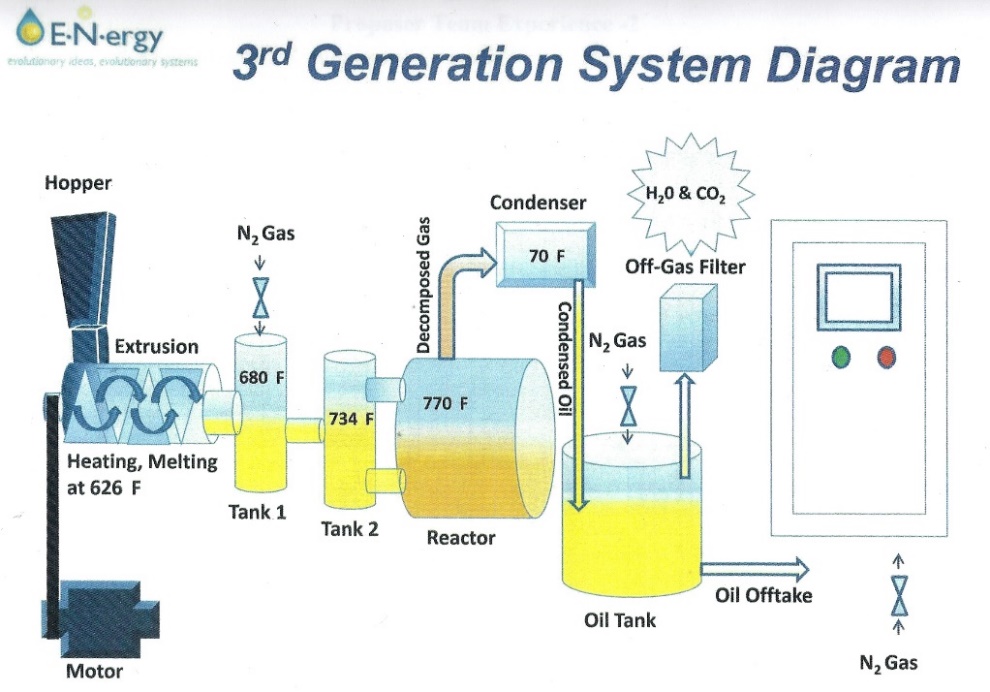
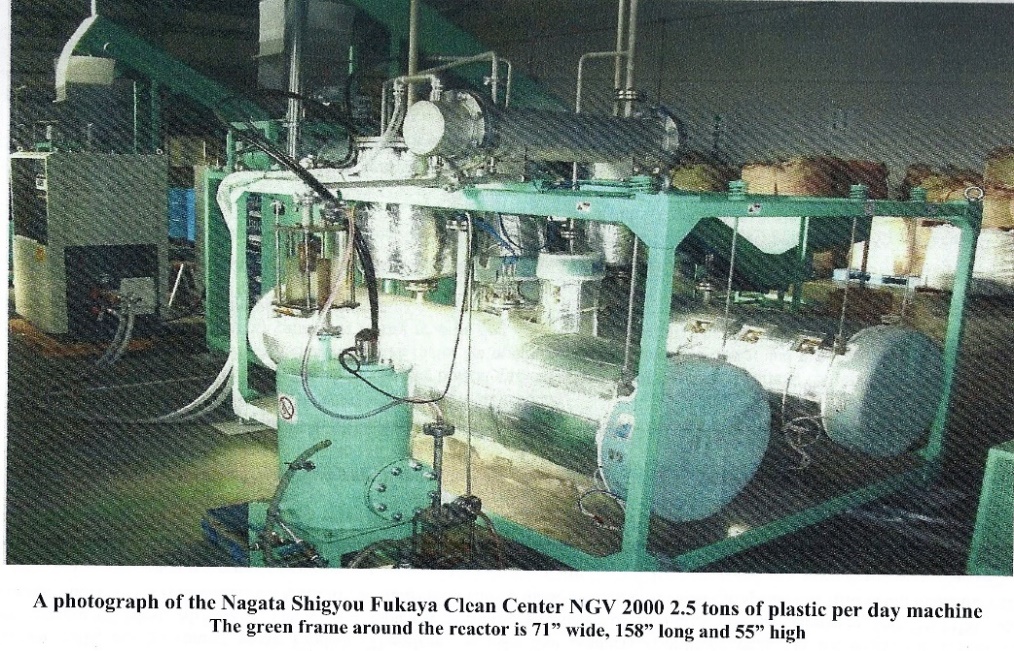
Unrecycled Plastics to Oil Module Footprint
Approximately 39.3 feet by 33.3 feet plus 59 feet by 70 feet for SynCrude storage tanks.
Unrecycled Plastics to Oil Module Processing and Process Management
The plastic will be stored until needed in a 1st in/ 1st out bunker and then fed to the Unrecycled Plastic to Oil Module. The reactors use Pyrolysis to convert the plastics into SynCrude, SynChar and a gas similar to Butane or Propane. The Module will consume 3.18 kW of electricity per gallon of SynCrude produced. SynChar and SynGas is also generated which is conveyed to the Power Module to be used as fuel to generate electricity.
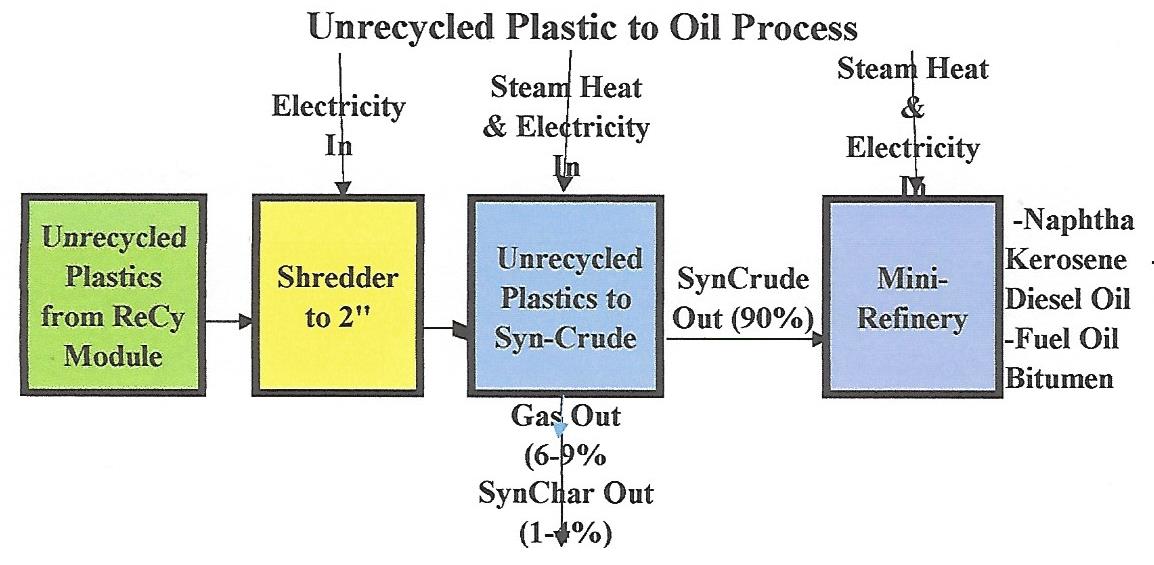
Unrecycled Plastics to Oil Module Product and Residue Handling and Management
The BTUs in the feedstock will, by weight of the by-products, be split with 90% in SynCrude, 9% in gas similar to Butane or Propane with 1% as SynChar. The SynCrude is piped to tanks at the batch crude oil separator. The SynCrude is then pumped to a batch crude oil separator that produces by-products that meet industrial specifications including Naphtha, Kerosene, Diesel Oil, Fuel Oil and Bitumen. All of these products are Carbon Neutral and will be sold into the local market. County of Kaua`i will have the ability to buy oil products at a discount. The Bitumen can be combined with the unrecycled inorganics to manufacture asphalt. The SynChar is moved to the Power Module by conveyer to be used as fuel. The gas will be pumped to a tank at the Power Module where it will be used as fuel.
The Unrecycled Plastics to Oil Module has no emissions and therefore needs no Environmental Controls.
Notes :
BUTs - British Thermal Unit : a traditional unit of heat; it is defined as the amount of heat required to raise the temperature of one pound of water by one degree Fahrenheit.
Addendum “A” – Diagram of the operation
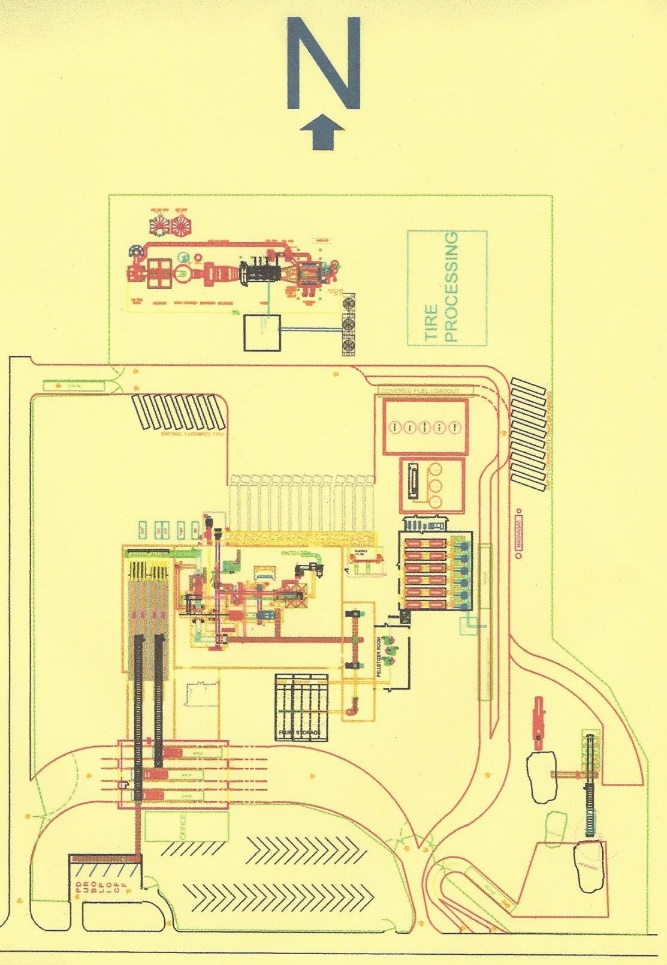
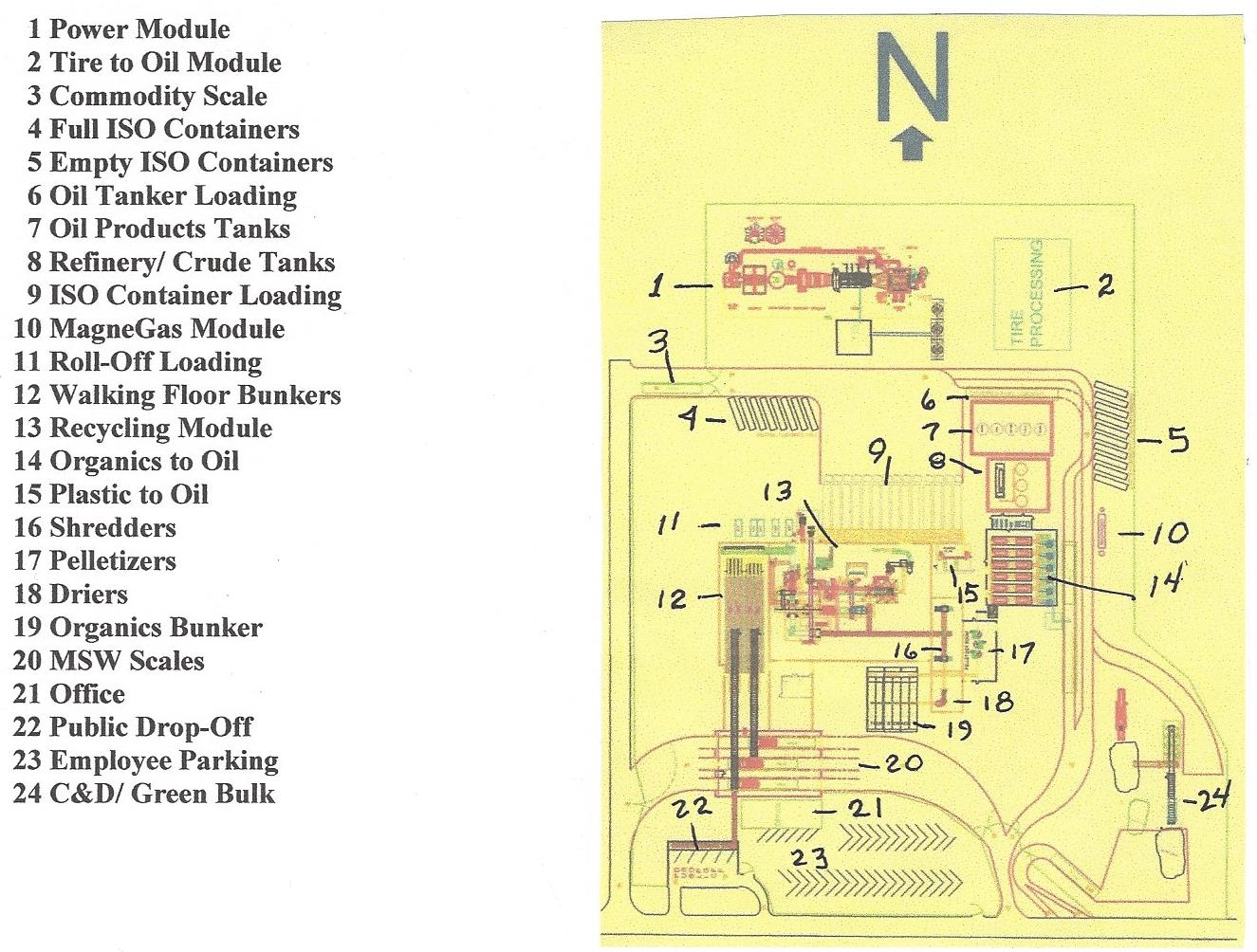
Addendum “B” – Team Experience
Proposer Team Experience
Organization Structure of Organic Waste Remediation LLC (OWR)
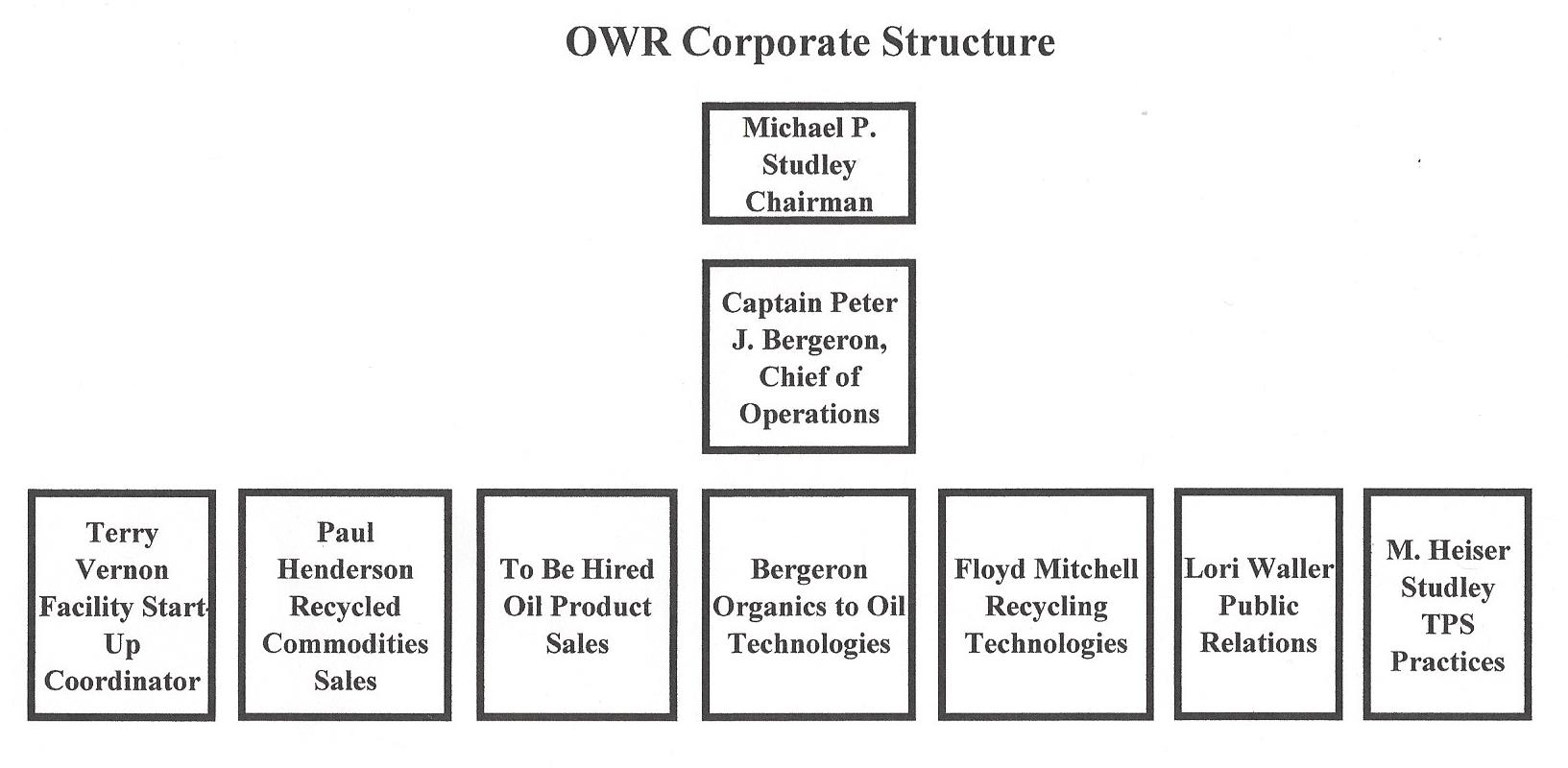
Copyright Fulmina Foundation
Powered by Froala Editor
